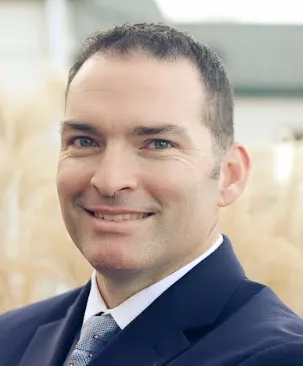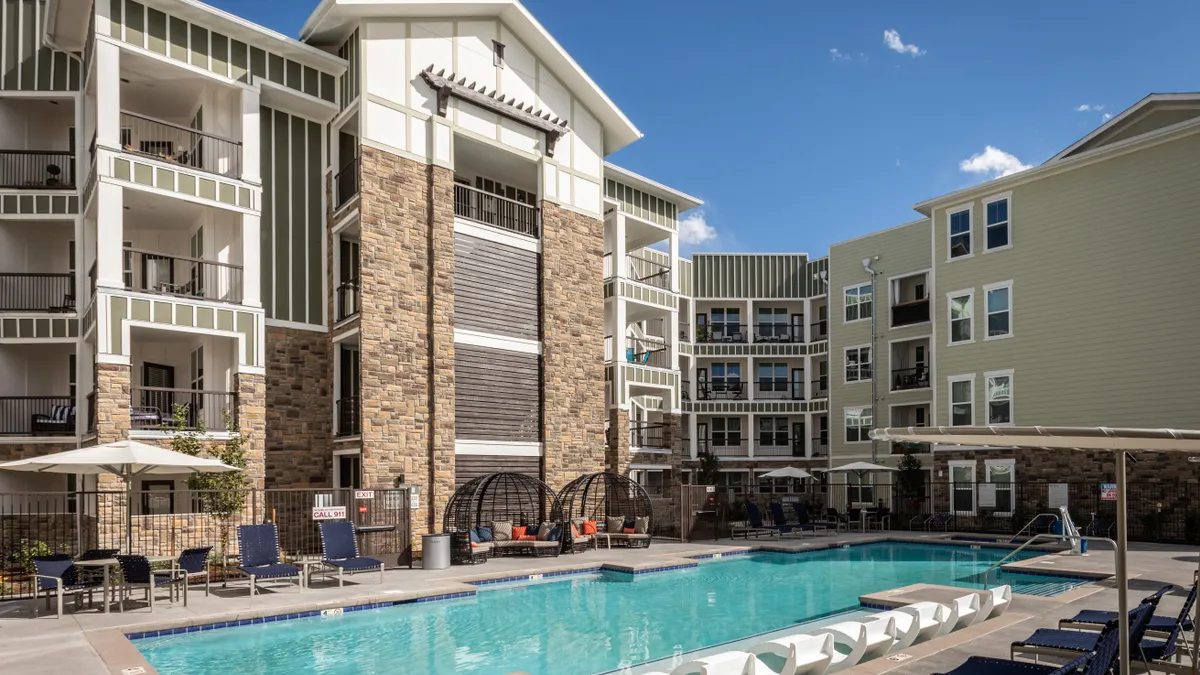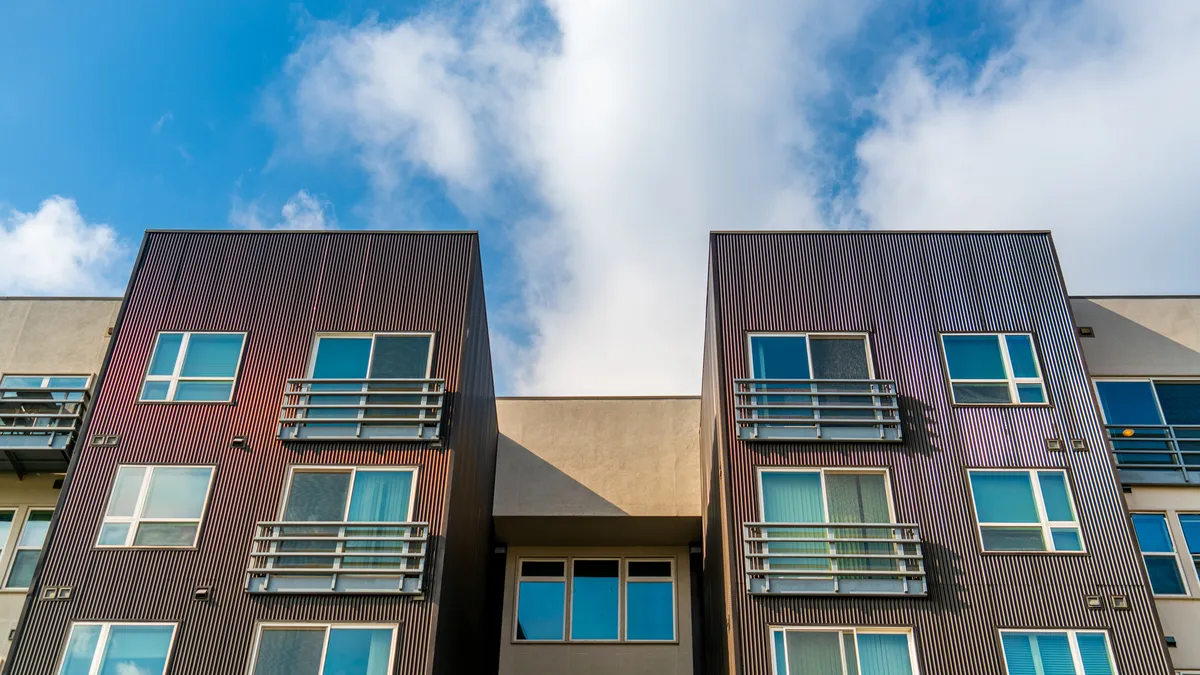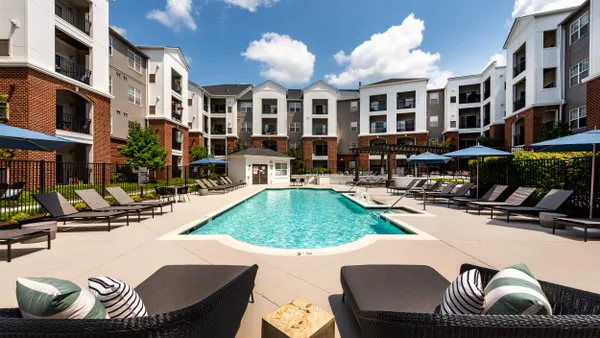When The Garrett Cos. builds new apartment properties, the goal is usually to hold the asset for three to five years. But the scalding hot sales market of the early 2020s changed things.
“Obviously, when the market is such where spreads between cap rates and build-on costs are so strong, it would be bad business not to sell them at that point,” Eric Garrett, founder and president of the Greenwood, Indiana–based apartment developer and manager, told Multifamily Dive.
With loads of supply hitting some of Garrett’s markets and buyers having difficulty getting loans, conventional wisdom would say that the sales market would slow as buyers pull back. But Garrett said that hasn’t been the case at an apartment community the company is finishing in Castle Rock, Colorado.
“I'm really shocked at the number of buyers coming to the table in that submarket and wanting to buy that property right now,” Garrett said. “So we will more than likely sell that project. We have another project called Gateway in the airport corridor of Denver. And we'll be finishing that about the same time, and it's seeing an equal amount of activity of people wanting to buy it.”
In its nine-year history, The Garrett Cos. has built more than 60 projects and more than 15,500 apartment units. It’s currently focusing on developing in Colorado, Arizona and Florida and has 26 properties under construction. The company manages the entire production process, from entitlements through construction and property management on suburban infill wood-frame projects that are usually 200 units or larger.
Here, Garrett talks with Multifamily Dive about construction finance, continued buyer interest in new properties and construction costs.
This interview has been edited for brevity and clarity.
MULTIFAMILY DIVE: How hard is it to finance deals now versus a year ago?
ERIC GARRETT: For us, not so much. Our average loan to cost has not changed this year versus last year, which is a little outside the norm. Because we control the construction process and have been doing this for a long time, we're able to build a cost basis that is typically better than a lot of our peers. That helps with the debt terms that we're getting.
How is looming supply in some of your markets affecting your strategy?
Certainly, in some of these micro markets, we're seeing a certain level of overbuilding or at least a lot of units coming online at one given time. Some of our deals are competing against three or four other projects in lease-up. And then with some of them, maybe there's one other project or no projects inside of our leasing area.

But we're certainly seeing pockets in different submarkets. For example, we're in Glendale, Arizona, right now. And, there's quite a bit of competition coming alive now for our project in Glendale. Over the next two to three years, does it absorb? Absolutely, even if we take a very conservative absorption ratio for that submarket.
If we run that analysis over three to four years, everything will be fine. In the next 12 months, though, it'll certainly be dicey and we'll start seeing some more concessions.
To what do you attribute the strong demand?
There is still a lot of capital out there. I think there are people that want to make deals happen. Yeah, the debt markets are a little dicey on the construction side. But obviously, with Fannie Mae and Freddie Mac’s backstop and with the 10-year [Treasury] staying somewhat in check, people were still able to leverage these deals and make them happen.
Now, one year ago, we could sell a property at 20% occupancy and people were buying them with bridge debt and everything else and getting really aggressive. I think that is different. To execute on a new deal today, you need to be stabilized or pretty darn close to stabilized so that somebody can go out and get permanent debt.
It will definitely take a little longer to sell some of these assets. But the demand is such and there's still enough capital chasing these deals that we will still be able to produce a sub-5% cap rate on the sale.
Is it easier to develop a building than it was a year ago?
A lot of our subs do not have the backlog that they did a year ago. So we're certainly getting their attention when we bring a new project out, which is nice having manpower on site.
Obviously, some materials, like lumber, are back down again, which is great. But a lot of materials are still holding steady. Labor rates are not changing much. So I don't know that we're going to see a dramatic shift in costs.
But I do think we will see a dramatic shift in time to build, and we should start getting back closer to equilibrium in terms of building a 200-plus-unit wood-frame project. That should be done in 12 to 15 months. But in the last couple of years, it has taken quite a bit longer than that because of just manpower shortages in most of these markets.
So I think that'll come back in balance and we'll start seeing better build times, which will help keep that cost down.
Click here to sign up to receive multifamily and apartment news like this article in your inbox every weekday.











